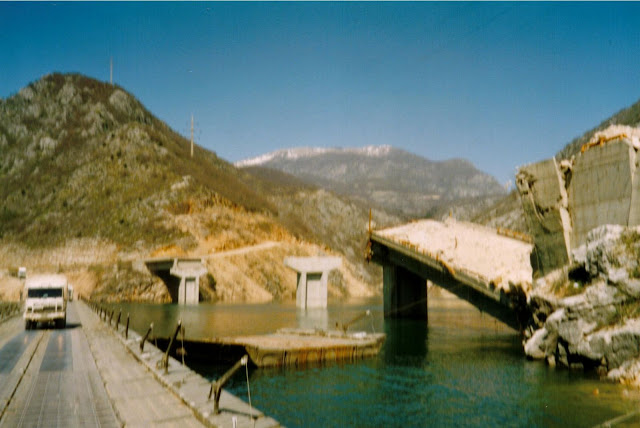Blog 14: Jablanica and Mostar
Jablinica and Mostar
For todays bright side of Mostar see: www.thebrightsideofbosnia.blogspot.comMostar
After the visit of the museum we traveled to Mostar. Presently the road along the Neretva is still a very scenic road and even in 1994 it was quiet impressive, however most of the bridges were destroyed and UNPROFOR built some floating pontoon bridges.
Destroyed bridge and pontoon bridge over the Neretva in 1994
Same location 2018
1995-Gravel road to the ponton
2018 - even the gravelroad to the pontoons is still there
1995 - This demolition failed and with some mitigation this bridge could be operate
2018 - The same location with the bridge repaired
To reach the Lukavac compound, one of the routes from Croatia was through Mostar. Due to the war the trip from Croatia to Lukavac was a 2 day trip and during my first trip to Lukavac we started in Split and we passed Mostar on the first day. This city was so heavily shelled that even the trees were completely dead and it looked like that each and individual stone was hit by more than one bullet hole. Also the street lighting was heavily hit by bullets.
Between June 1993 and April 1994 the HVO (the Bosnian Croation Army) besieged Bosniak-concentrated East Mostar, resulting in many deaths of civilians, a cut off of humanitarian aid, damage and destruction of the building and houses and the blowing up of the historic Stari Most bridge.
Hostilities ended with the signing of the Washington Agreement in March 1994 and the establishment of the Croat–Bosniak federation. The following documantaire shows a good overview of the Siege of Mostar.
Pictures are saying more than 1000 words……
I can promise you that in 1994 nobody of us was prepared for this scale of destruction and all the guys in the trucks were completely silent till we had time to do the first piss in a safe place.
Mostar was "the most heavily destroyed city in Bosnia and Herzegovina". The most affected area was in Bosniak populated east Mostar and the Bosniak part of west Mostar where around 60 and 75 percent of buildings were destroyed or very badly damaged. The siege resulted in more than 2,000 deaths and over 6,000 were injured.

The reconstruction of the destroyed Stari Most bridge was commenced on 7 June 2001 and the reconstructed bridge was inaugurated on 23 July 2004.
Present view of the bridge (2018)
Presently Mostar still shows even 2018 signs of war. If you walk a few blocks from the touristy Old Town, you will still see several bombed out buildings. The Mostar Boulevard is still a ‘dividing line’ that both Croats or Bosniaks will not cross.
The Old City of Mostar
Jablanica
We traveled from Sarajevo to Jablinica. In Jablinica we visited the Museum of Battle for the Wounded on the Neretva River which was opened 12th November 1978 in occasion of marking the 35th anniversary of battle on Neretva. In 1994 Maybe our military instructors told us this story during our training and preparations in the summer of 1994 but I forgot that story.
During fightings in World War 2 between Tito’s partisans and a German force supported by armoured brigades, Tito’s partisans escaped to the opposite side of the river by using a smart trick. The partisans were blocked by Cetniks on the other side of the river, however they blew up the bridge in such a way that, from the air, it looks like that the bridge was destroyed. The Germans changed their course and started redeploying northwards because they thought that the Partisans were probably planning to push north along the west bank of the river. This gave the Partisans sufficient time to repair the bridge temporarily and they stormed the east bank of the river and overwhelmed the Chetnik forces and Tito and his Partisans escaped.

































Comments
Post a Comment